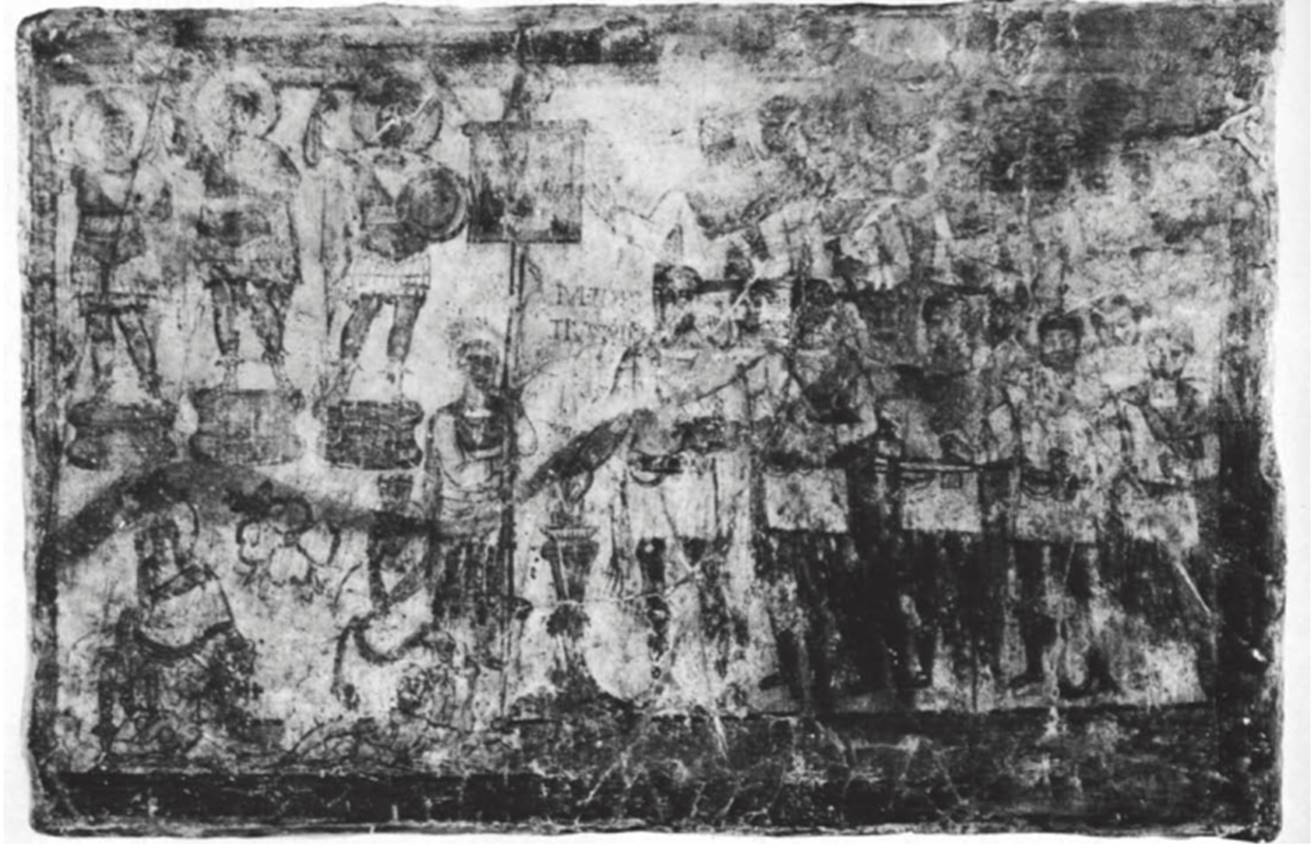Panel with sacrifice of Julius Terentius to the Palmyrene gods. Temple of Bel, Dura Europos, about 239. Fresco secco
The Yale-French archaeological expedition to Dura in 1922 and 1923 discovered the Terentius panel among the votive paintings on the north wall of the pronaos of the Temple of Bel. This panel, apparently painted over an earlier votive, is carefully framed by red and yellow bands forming an oblong register, an established format for devotional imagery in the art of the ancient Near East. The figures in the panel are strongly outlined against a white ground, accented with red, pink, orange, yellow, and mauve washes. Although the painter made some attempt to develop the figures three-dimensionally, he created a flat conceptualized composition, largely determined by the frontal, hieratic character of his traditional models.

The panel divides into two unequal parts, separated by a vexillary, who stands left of center, holding up the standard that identifies the unit as the Twentieth Palmyrene cohort, an auxiliary force stationed at Dura on frontier duty. To the right, the members of the cohort have been arranged schematically in two rows, following the Late Antique convention for group compositions that equated “above" with "behind." Terentius, their tribune, stands prominently near the center of the panel at the head of their ranks, making an offering at a thymiaterion. He is also clearly identified by a Latin inscription: iVL(ius) terentivs TRro(unus). The soldiers behind him make the right-handed gesture of adoration, as does the leading figure in the upper row, identified by a Greek inscription as Themes, son of Nokimos, priest. The names are Palmyrene, which suggests that Themes may have been the official priest or chaplain of the unit because he has been singled out in addition to the tribune. Despite the damaged surface, the overriding static quality of the ranks preserves the sacred nature of scene and act.
In this polyglot context the representations that occupy the left part of the panel fit very well. On the bottom, separated by a large rose symbolic of abundance, appear two similar, draped females, seated on rocks and readily recognizable as Hellenistic city personifications (see nos. 154, 155). Both are identified by Greek inscriptions: the Tyche of Dura, with the attributes of mural crown and a male personification of the Euphrates emerging from beneath her feet at the right, and the Tyche of Palmyra at the left, accompanied by a nude female below, probably personifying the oasis spring of Ephka, whose waters brought life to Palmyra. The halo, lion, and small altar shown beside the Tyche of Palmyra indicate that she also incorporates elements of the goddess Atargatis (no. 160), consort of Bel, master of the temple.
Three golden-nimbed figures in military dress holding various attributes dominate the upper left corner. Identified as the Palmyrene triad of male gods, patrons of war and of soldiers (see Kantorowicz, 1961), they anticipate the protective patronage later offered the Christian soldier by the military St. George. Iarhibol, the solar god, is on the left; Aglibol, the moon deity, on the right; and between them holding a globe appears Bel or Baalshamin, god of the sky, president of the triad of the great gods of Palmyra, in Roman costume.
These Palmyrene gods stand on bases like statues, as if images of their images. Thus, the Terentius panel manifests in perpetuity an offer of devotion given by the Palmyrene soldiers to the gods of their homeland, protective presences in Dura. Bibliography: Cumont, 1926, pp. 89-114, 363, 364, pis. xxv, xlix-li; Rostovtzeff, 1935, pp. 245-247; Rostovtzeff, 1938, pp. 71, 72; Colledge, 1976, pp. 228, 229, fig. 60.
Date added: 2025-08-31; views: 95;
